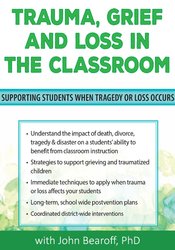Description
- Understand the impact of death, divorce, tragedy & disaster on a students’ ability to benefit from classroom instruction
- Strategies to support grieving and traumatized children
- Immediate techniques to apply when trauma or loss affects your students
- Long-term, school wide postvention plans
- Coordinated district-wide interventions
For your students, death, illness, divorce, natural disaster, community violence, or even a move to a new school can result in grief reactions and related trauma. Any of these events can trigger plummeting grades, decreased class participation, negative acting-out behavior, or dropping out of extracurricular activities. Watch this engaging seminar and learn how the intensity and duration of the different stages of child/adolescent grief will manifest in school. Students may break down crying, become emotionally withdrawn, severely depressed, or show extreme mood swings. Dr. Bearoff will show you specific strategies, techniques and interventions to provide the appropriate support to effectively help students dealing with trauma, grief and loss. Whether you are a classroom teacher, a school counselor, an administrator or support staff you will leave this seminar armed with interventions to address grief, tragedy and trauma on an individual level, a classroom level and even a school-wide level.
CPD
CPD
- PESI Australia, in collaboration with PESI in the USA, offers quality online continuing professional development events from the leaders in the field at a standard recognized by professional associations including psychology, social work, occupational therapy, alcohol and drug professionals, counselling and psychotherapy. On completion of the training, a Professional Development Certificate is issued after the individual has answered and submitted a quiz and course evaluation. This online program is worth 6.0 hours CPD for points calculation by your association.
Faculty
John Bearoff, PhD, has over 40 years of experience in a wide variety of settings including as a classroom teacher, substitute teacher, school psychologist, and private practitioner. This diverse background allows John to speak from a unique perspective of understanding - on all levels. John is a Certified School Psychologist and Clinical Psychologist.
Dr. Bearoff has conducted more than 300 in-service programs to school districts around the country. Topics for educators include grief/loss intervention, stress management with students and staff, crisis intervention, depression and suicide intervention and creating safe schools. John has been responsible for initiating and developing district wide programs on grief/loss intervention/postvention, student assistance programs for drug and alcohol intervention. He also created suicide prevention and anti-bullying programs for several large school districts.
In addition, John has been the chairperson for school district committees created to establish district-wide Safe Schools plans. He has also been the chairperson for multicultural awareness committees, which established school district policies relating to diversity and tolerance.
Speaker Disclosures:
Financial: John Bearoff is in private practice. He receives a speaking honorarium from PESI, Inc. He has no relevant financial relationships with ineligible organizations.
Non-financial: John Bearoff has no relevant non-financial relationship to disclose.
Objectives
- Assess the effects that grief and trauma reactions have on grades, class participation, behavior, social interactions, and extracurricular activities.
- Determine the stages of grief, and their behavioral, emotional and academic impact, at each developmental stage.
- Implement effective in-school one-to-one interventions with a child who has recently experienced the death of a family member.
- Consider when you would use classroom versus school-wide interventions.
- Explore the effects of major changes, such as moving to a new school, as a significant loss that triggers grief and trauma reactions.
- Analyze the most effective community resources and services that parents can access to help their grieving or traumatized child.
- Develop long-term, school-wide postvention plans to be implemented following specific losses, tragedies and disasters.
Outline
The Universal Experience of Trauma, Grief & Loss
- Stages of grief: normal progression vs. pathological grieving
- Commonly held misconceptions of about grieving
- Types of losses and events that trigger grief & trauma
- Our personal loss history – how it affects our response to our students
Manifestation of Trauma and Grief in Students
- Most important ways in which kids reactions differ from adult reactions
- Childhood trauma and grief: normal vs. abnormal
- Acute and chronic feelings following loss and trauma
- Child/adolescent reactions: concrete, black-and-white, tendency to generalize, repetitive, physical, cyclical
- The effects of trauma and bereavement on school performance and behavior
Interventions for Loss at Each Developmental Stage
- Behavioral changes and warning signs indicating the need for support
- Differences between intervention for children and adolescents
- Case examples
One-to-One In-School Interventions for Trauma, Grief, and Loss
- The Big Four: death, divorce, illness, and abuse, when and how to intervene
- Strategies to encourage students to talk about their loss
- Techniques to validate expression of feelings
- Tips to confront and overcome irrational fears
- Individuals’ current and future safety, security
Classroom Wide interventions
- Impact of an individuals’ loss on the whole classroom: how to help
- Large-scale tragedies and disasters: how to help
- Strategies to encourage students to help grieving classmates
- Answering students’ most frequent questions
- The impact of a new student on both the student and your classroom
- Steps to create student support groups
Interventions to Support Students Outside of School
- Effective strategies to assist parents in helping their children
- In-school resources to offer parents
- Connect parents to outside resources for children and themselves
Support for Staff Members
- Proactive strategies to prepare staff for trauma, grief and loss
- Interventions and support for teachers following trauma, grief and loss
Postvention Plans for your School and District
- Immediate short term interventions for your school
- Coordinate short term interventions with your district
- Long term, school and district interventions
- Case examples of established, successful postvention plans
Target Audience
Counselors, Teachers/Educators, Nurses, Occupational Therapists & Occupational Therapy Assistants, Psychologists, Social Workers, Speech-Language Pathologists and other Helping Professionals who work with Children

